


Are you an avid mountain biker who takes to the city streets once in a while? Or maybe you’re considering buying a mountain bike and wondering if it can handle the trail and daily commute? An often burning question arises: “Is it hard to ride a mountain bike on the road? The answer lies in the unique features of mountain bikes and their interaction with the smooth pavement of the cityscape.
Read More : ” Hybrid VS MTB Cycle “
In short, the answer is yes, riding a mountain bike on the road can be harder due to increased rolling resistance from aggressive tires and less efficient suspension on smooth surfaces.
Mountain bikes are specially designed for off-road adventures, equipped with durable tires, a strong frame, and a sophisticated suspension system to tackle rough terrain. While their rugged performance is great in harsh conditions, they can pose some problems on asphalt surfaces.
On the road, mountain bike tires with aggressive treads can create more rolling resistance, which requires extra effort to maintain speed. A suspension system optimized for bump absorption may be less effective on flat roads, resulting in a loss of power.
However, mountain bikes also offer certain advantages for city riding, such as greater stability and better control over uneven surfaces. Additionally, the versatile nature of mountain bikes allows riders to tackle a variety of terrains without the need for multiple bikes.
In this article, we’ll explore the features of road mountain biking, examine the pros and cons, and provide valuable tips for making your city adventures fun and rewarding. So let’s explore the exciting world of unusual mountain biking!
Read More: Are mountain bikes harder to pedal.
Tackling the Road: Challenges of Riding a Mountain Bike
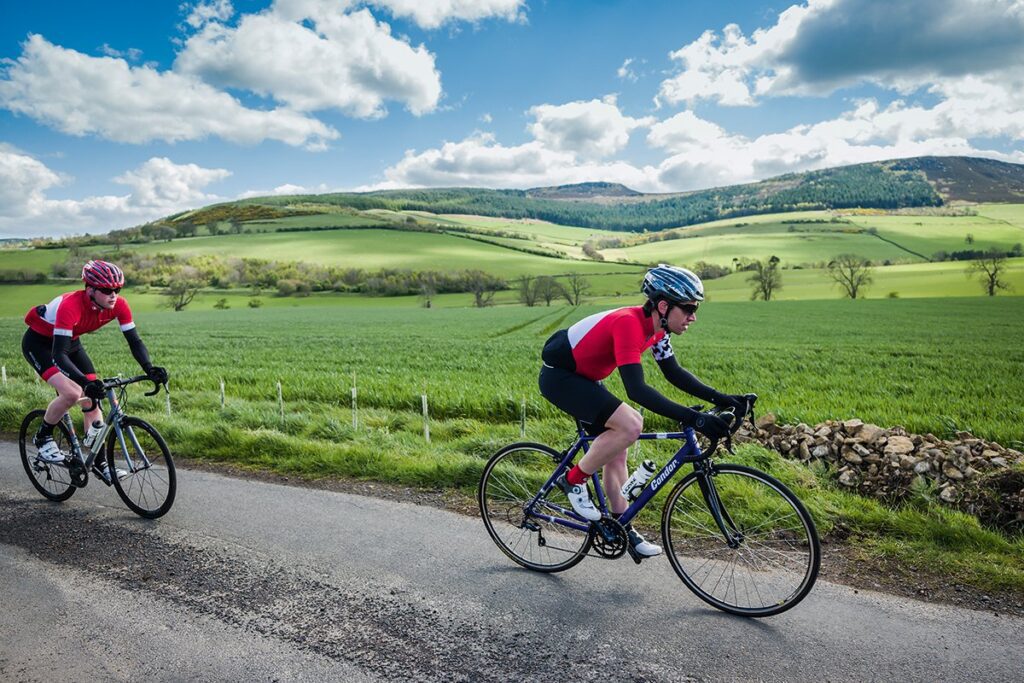


Mountain biking is an exciting adventure, but what happens when you take your mountain bike on the road? While it sounds like a fun idea, road mountain biking comes with its own set of problems.
Read More : ” Is Cycling Harmful For Knees? “
- Tire Tread:
Mountain bike tires have an aggressive tread pattern for superior traction in tough terrain. On flat roads, however, this wide, raised tread can create more rolling resistance, make pedaling difficult, and reduce overall efficiency.
This increased drag can be especially noticeable on the highway when trying to maintain a higher speed.
- Frame weight and geometry:
Mountain bikes are generally heavier than road bikes and have a flatter frame geometry. The added weight and less aerodynamic design can make it harder to accelerate and maintain higher speeds on flat roads.
The upright position can also increase wind resistance and requires more effort to maintain momentum.
- Handling and stability:
Mountain bikes are optimized for stability and control on rough terrain, but this can result in reduced agility on flat roads. Turns and maneuvers are less responsive and require more effort to navigate around turns and bends.
- Riding Position:
When riding a mountain bike, a more upright position can put more weight on the saddle, which increases pressure on the sit bones. This can cause discomfort on long rides, affecting durability and overall enjoyment.
- Maintenance:
Road mountain biking can accelerate tire wear due to the abrasive nature of asphalt and concrete surfaces. Frequent inspections and proper maintenance are essential to ensure optimum performance and safety.
- Adaptability:
Despite the challenges, mountain bikes can be used on roads, and this versatility allows riders to explore different terrains. By combining on-road and off-road experiences, it offers a unique adventure and broadens the horizons of cycling.
- Fun:
While road mountain biking can be more challenging than road bikes alone, many cyclists still enjoy the ride. The excitement of discovering new places and overcoming obstacles on a mountain bike can make this activity interesting.
Having said that, road mountain biking can present some challenges, but with the right setup and mindset, it can be a fun experience. Take part in the adventure and you will discover a new dimension of your cycling journey.
Read More: Is mountain biking hard.
The Battle of Tires: Road vs. Mountain Bike Tread
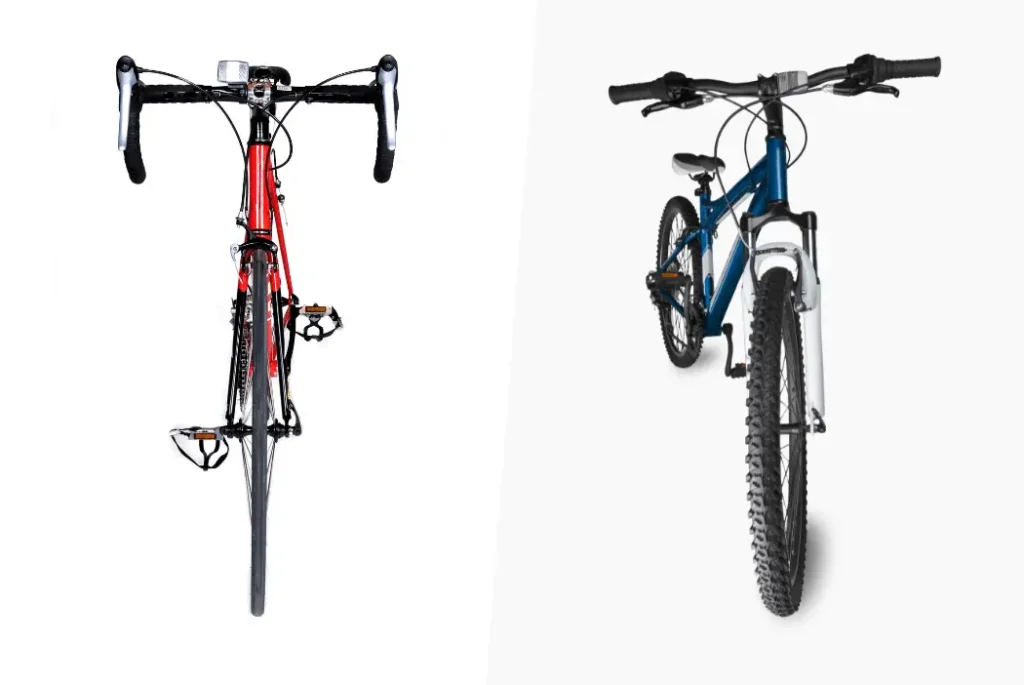


When it comes to cycling, the type of tires you choose can affect your riding experience. Road bike and mountain bike tires come in a variety of tread patterns to give them excellent performance in their respective conditions. Understanding the differences between these two tire types will help you make the right choice for your cycling adventures.
Road Bike Tires:
Road bike tires have a smooth and slick tread pattern. This design provides minimal rolling resistance, allowing the rider to reach higher speeds on paved surfaces with less effort. The reduced tread also improves handling, making road bike tires ideal for fast riding and racing.
However, these tires can perform on loose or rough terrain due to limited traction.
Mountain Bike tires:
Mountain bike tires have a wavy, aggressive tread pattern. This design provides excellent traction and stability on uneven and unpredictable terrain. Deep grooves and lugs trap mud, dirt, and rocks for better control and slip prevention. However, the extra tread in mountain bike tires can create more rolling resistance on smoother surfaces, resulting in slower shifting on the road.
Choosing the right tread depends on your riding preferences and the type of terrain you use frequently. If you mostly ride flat or paved roads, road bike tires are the best choice due to their efficiency and transmission. On the other hand, if you like to travel off-road and tackle rugged terrain, mountain bike tires are the best way to get superior traction and durability.
At the end of the day, the tire war comes down to your riding style and where you want to go on your bike. Whether you prefer the transmission and agility of road bike tires or the durability and versatility of mountain bike tires, both options offer unique benefits and can enhance your cycling experience.
So choose the tires that best suit your adventure and get ready to hit the road or trail with confidence!
Related: How long should a mountain bike tire last.
Efficiency vs. Comfort: The Dilemma on Smooth Surfaces
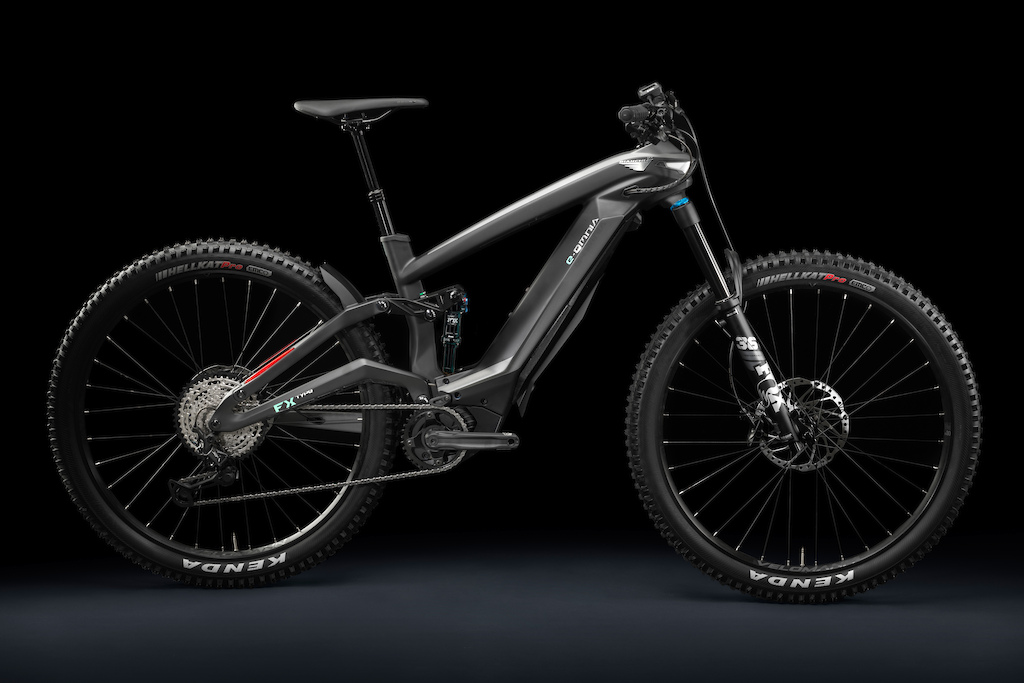


Let’s dive into the dynamics of this dilemma and learn how to make the best choice for your cycling adventure.
Efficiency:
Efficiency means how easily and smoothly you pedal and maintain your speed on a smooth surface. With smooth tread and low rolling resistance, road bike tires are very efficient. It is designed to minimize friction, allowing you to glide easily and reach higher speeds with minimal effort.
This makes the road bike ideal for long-distance and competitive races where speed and endurance are important.
Comfort:
Comfort refers to your bike’s ability to absorb road vibrations and shocks, resulting in a smoother and more enjoyable ride. Complex tread and high-volume mountain bike tires provide better cushioning and traction on uneven surfaces. This makes mountain bikes suitable for off-road and city riding where comfort and stability are important.
Solution:
The choice between efficiency and comfort depends on your goals and preferences. If your main focus is long distances on flat or racing roads, a road bike with efficient tires is your best bet. On the other hand, if comfort is your priority and you enjoy exploring different terrains, a mountain bike with shock-absorbing tires will provide you with a more enjoyable riding experience.
Hybrid bike:
If you’re undecided between the two, consider a hybrid bike that combines elements of a road bike and a mountain bike. Hybrid bikes have a more upright and comfortable riding position, making them suitable for the occasional commute and daily commute. They usually come with semi-slick tires that combine road performance with a wide tread for easy off-road riding.
Ultimately, the choice between efficiency and comfort depends on personal preference and the type of driving you prefer. Whether you’re an avid road racer or a casual city cruiser, finding the right balance between these factors will result in a more enjoyable and rewarding ride. So go ahead, test the waters, and find the perfect bike for your riding style!
Read More: Why are full suspension bikes so expensive.
Adjusting Your Ride: Tips for Riding a Mountain Bike on the Road



Mountain biking is great, but what if you happen to be on a flat road instead of a bumpy one? Don’t worry! With a few tweaks and simple tricks, you can make mountain biking as comfortable and efficient as you would on the road. Here are some valuable tips to help improve your driving experience on the road:
- Tire pressure:
Decrease the pressure in your mountain bike’s tires when driving on the highway. This increases the contact patch resulting in better traction and a smoother ride. Remember too low pressure can lead to increased rolling resistance so find the right balance for optimal performance.
- Suspension lock:
Many mountain bikes have lockable suspension forks. Activate the lockout feature to make the
bikes stiffer, reduce energy loss and improve pedaling efficiency on smooth surfaces.
- Choose the right gear:
Choose a gear that allows you to maintain a stable cadence without pushing too hard. On level ground, select a higher gear to maximize speed, and downshift on slopes for easier pedaling.
- Riding Position:
Adjust the fit to be more aerodynamic to reduce wind resistance. Lower your body slightly and bend your elbows to minimize drag and increase speed.
- Soft Pedal Attack Resistance:
Focus on smooth, consistent pedaling. Avoid sudden movements and use both feet evenly to distribute power better.
- Be careful with brakes:
Mountain bikes often have powerful disc brakes that can be aggressive on the road. Apply the brake slowly to avoid sudden stops and continue forward at a constant speed.
- Stay in sight:
Visibility is very important for safety when driving on the highway. Wear shiny or reflective clothing to be visible to drivers and use bike lights, especially in low-light conditions.
- Consider another bike:
If you often ride smooth surfaces, you might want to consider getting a hybrid or road bike. These bikes are specially designed for road riding and provide a more efficient and comfortable ride.
So even though mountain bikes are designed for rough terrain, with a little tweaking you can enjoy a smooth and efficient ride on the road. Take advantage of the versatility of your mountain bike, customize it, and ride with confidence and fun!
Remember that the ability to adapt is the key to getting the most out of your cycling adventure. Good attitude!
Related: Can you ride a mountain bike on the road.
Embracing the Adventure: Mountain Biking on Different Terrains



Mountain biking is an exciting outdoor activity that allows riders to connect with nature, test their skills and discover the joy of discovery. One of the most exciting aspects of mountain biking is the diversity of terrain it offers, each with its unique challenges and rewards.
Whether you’re a seasoned mountain biker or just getting started, exploring different terrains can take your cycling experience to a new level.
- Forest Trails:
Enter a dense forest with narrow paths and dense vegetation. Spotted sunlight, winding paths, and occasional obstacles make forest trails interesting and exciting.
- Rocky Mountains:
Test your skills and courage on rocky terrain with challenging technical ups and downs. The rough, unpredictable surface requires careful handling and gives a sense of accomplishment when conquered.
- Desert Dunes:
Embark on a desert adventure as you traverse dunes and drylands. The soft bog creates a whole new dimension of cycling that requires balance and agility.
- Alpine Escapes:
Hike on high mountain trails surrounded by stunning mountain scenery. The fresh air and steep climbs give a sense of accomplishment, while the descents are exhilarating.
- Coastal Cruises:
Enjoy a coastal walk with stunning ocean views. The combination of sandy trails and cliffs provides a unique and exhilarating cycling experience.
- Urban Adventures:
Explore your city’s alleys and parks, find hidden treasures, and enjoy a quick escape from the busy city life.
- Mountain Bike Parks:
Head to a private mountain bike park with features like jumps, ledges, and descents that provide an adrenaline-pumping playground for riders of all skill levels.
- Winter Wonderland:
In colder months, try riding fat bikes on snowy roads, flying over snowy landscapes.
Experience the adventure and diversity of mountain biking as you explore different terrains. Each journey will offer new challenges, rewards, and a deeper connection with nature. When cycling, remember to wear suitable protective gear, take essentials and respect the environment.
Get ready, hit the road, and let the exciting world of mountain biking take you on an unforgettable journey of adventure and self-discovery!
Read More: How to ride a mountain bike uphill.
Finding Balance: Making the Most of Your Mountain Bike on the Road
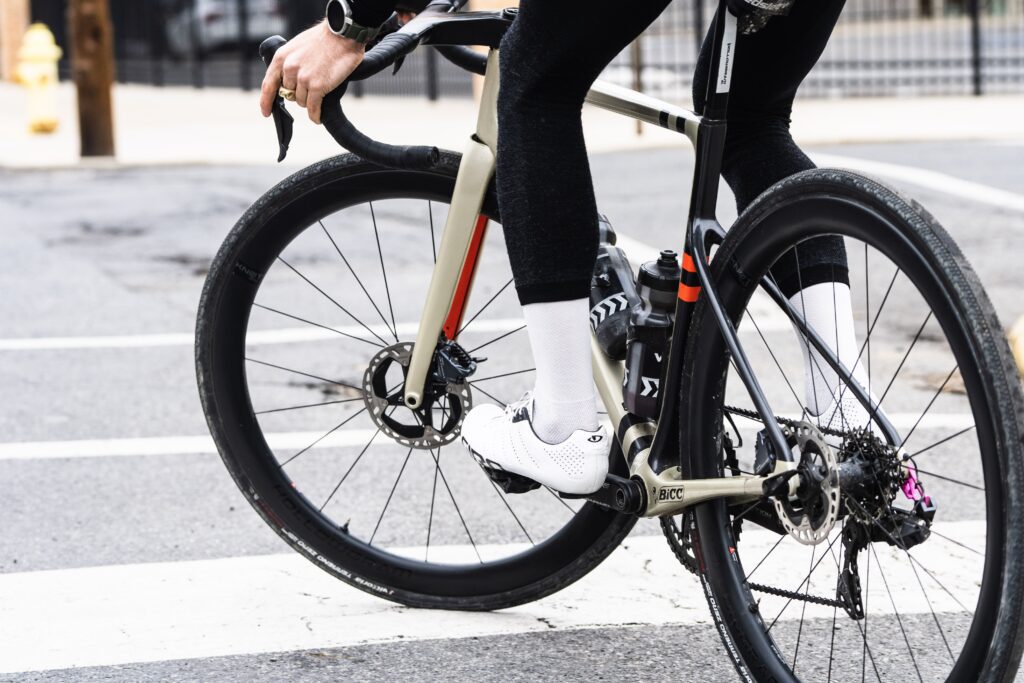


While mountain biking can be fun and adventurous, sometimes you might find yourself cycling on paved roads and city trails. Knowing how to get the most out of your mountain bike on the road can improve your cycling experience, whether it’s an enjoyable city ride or the need to access off-road trails.
Here are some tips for finding the perfect balance and enjoying mountain biking on the road:
- Tire pressure:
Adjust tire pressure to increase traction and reduce rolling resistance. Lower pressure provides better traction, while higher pressure provides a faster and smoother ride on flat surfaces.
- Positioning:
Optimize your position for road traffic. Lower your body and straighten your back to reduce wind resistance and increase speed and efficiency.
- Gear Shifting:
Use a higher gear ratio on the road for faster and smoother pedaling. Adjust your gear to suit the terrain and optimize your performance.
- Lockout Suspension:
If your mountain bike is equipped with lockout suspension, use it on the road to minimize energy loss and improve power transfer.
- Tire Selection:
Consider using semi-slick or road-condition tires for the best driving performance. These tires have reduced rolling resistance while still providing adequate traction on paved surfaces.
- Smooth Cadence:
Maintain a constant cadence to avoid unnecessary strain on your knees and improve efficiency.
- Brake responsibly:
Pay attention to braking, especially when driving on highways at high speeds. Brake gradually to maintain control and reduce the risk of skidding.
- Explore City Roads:
Ride your mountain bike to explore city streets, bike paths, and parks in your city. These areas can offer unique views and experiences not found on traditional routes.
When riding a mountain bike on the road, always keep safety in mind, wear appropriate equipment and pay attention to other road users. By finding the right balance and making the appropriate adjustments, you will be able to navigate any terrain with confidence and comfort and maximize your mountain bike’s versatility off the beaten track.
So go ahead, discover new routes, and enjoy the ride on your reliable mountain bike!
Read more: Can you use a hybrid bike for mountain biking.
Road Bike vs. Mountain Bike: Which is Better for Smooth Surfaces?
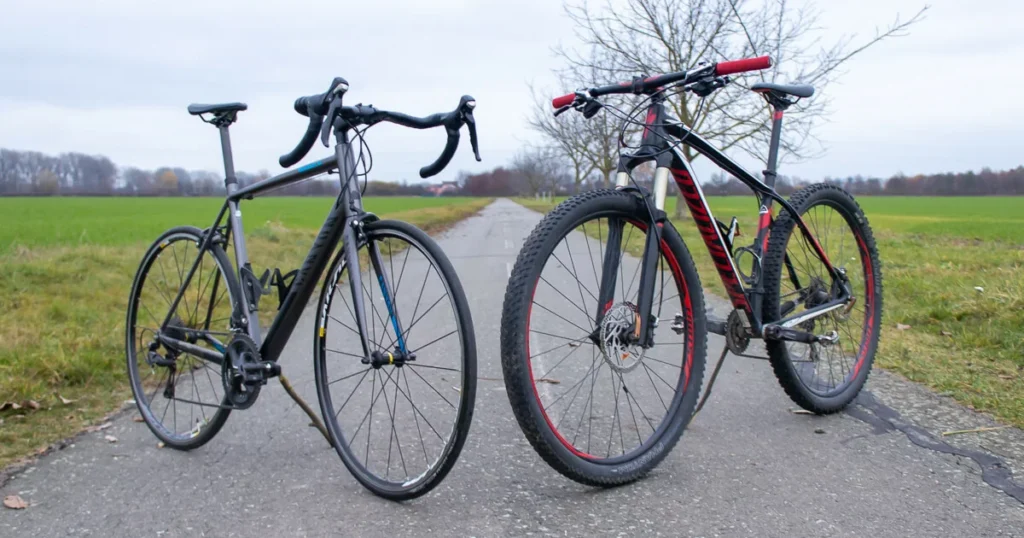


Choosing between a road bike and a mountain bike can be a tough decision when it comes to riding on smooth surfaces. Each type of bike offers its advantages and the right choice depends on your preferences and riding style. Let’s take a look at the road bike and mountain bike features to help you make the right decision for road adventures:
Road Bike:
- Speed and efficiency:
Road bikes are designed for speed and efficiency on asphalt surfaces. Its lightweight frame, narrow tires, and aerodynamic design provide a faster ride and less drag on flat roads.
- Riding Position:
Road bikes typically have a more aggressive low handlebar position that helps minimize wind resistance and provides a lighter ride.
- Smooth Ride Quality:
The width and pressure of a road bike tire, combined with the rigid frame, provide a smoother, more responsive ride on well-paved roads.
Mountain bike:
- Versatility:
Although not specifically designed for smooth surfaces, mountain bikes offer versatility. They can tackle a variety of terrains, making them suitable for off-road adventures.
- Comfort:
Mountain bikes often have a more upright riding position, and this may be more comfortable for some riders, especially on long rides.
- Durability:
Mountain bikes have stronger frames and wider tires, making them more reliable and able to tackle tougher surfaces when your smooth ride takes unexpected turns.
Ultimately, choosing between a road bike and a mountain bike for a smooth ride depends on your riding preference, your goals, and how you plan to use your bike. If you’re looking for speed and efficiency on well-paved roads, a road bike is probably your best bet.
However, if you’re looking for a versatile bike that can handle a variety of terrain conditions, including the occasional smooth ride, a mountain bike might be for you. Whatever bike you choose, whatever type of bike you use, remember that the fun of cycling comes from the freedom and adventure it provides.
Happy biking!
Related: Difference between a mountain bike and gravel bike.
Conclusion:
In conclusion: “Is it hard to ride a mountain bike on the road?” It is a controversial issue among cyclists. Mountain bikes’ unique design and features, such as wider tires and suspension systems, can generate more friction on flat surfaces than road bikes. However, with the right setup and tricks, you can still enjoy road mountain biking.
Ultimately, the difficulty of road mountain biking depends on individual preference and the specific terrain you’re facing. If you mostly ride on paved surfaces and prioritize speed and efficiency, a road bike is probably your best bet. However, if you enjoy the versatility and excitement of off-road riding and flat roads, mountain biking can provide a more challenging and exciting experience.
In the end, the choice between mountain biking and road biking depends on your riding style and the type of cycling adventure you seek. Whichever you choose, the joy of cycling is in the freedom, exploration and sense of accomplishment that it brings.
So let’s go on a two-wheeled adventure on the road and trails! Happy biking!
FAQs:
How much harder is it to ride a mountain bike than a road bike?
Riding a mountain bike on smooth surfaces like roads can be noticeably harder due to its wider tires, heavier build, and suspension, causing more resistance and slower speed compared to road bikes.
How much slower is a mountain bike to a road bike?
On average, a mountain bike can be around 10-15% slower than a road bike on flat, smooth surfaces due to its wider tires, heavier frame, and less aerodynamic design.
Is it harder to pedal a mountain bike on the road?
Yes, it can be harder to pedal a mountain bike on the road due to its heavier frame, wider tires, and less efficient geometry compared to a road bike.
Why are mountain bikes harder to ride?
Mountain bikes can be harder to ride due to their heavier weight, larger and knobby tires, and less aerodynamic design, making them less efficient on smooth surfaces like roads.
Are mountain bikes as fast as road bikes?
No, mountain bikes are generally not as fast as road bikes due to their heavier weight, wider and knobby tires, and less aerodynamic design. Road bikes are designed for speed and efficiency on paved surfaces.



Welcome to Bikegenics, where passion meets performance! We are a leading online destination for all things related to mountain biking, dedicated to providing you with top-notch gear, expert advice, and an immersive community to fuel your two-wheeled adventures. With a commitment to excellence and a deep love for the sport, we strive to elevate your biking experience to new heights.
